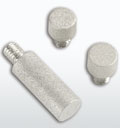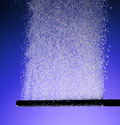 |

|
| Spargers for Bioreactors and Fermentors |
| Our quick change sparger design reduces the time and effort it takes to replace sparger elements in bioreactors and fermentors. The porous metal element can be purchased with a uniquely designed adapter that allows easy assembly to the mating sparger tip and easy removal for replacement after each batch. These spargers are durable, corrosion resistant and provide exceptional mass transfer efficiency. They are designed to comply with ASME-BPE specifications. |
|
|

|
Quick Change Sparger System for Bioreactors and Fermentors
Sparging and Mass Transfer from Gases to Liquids
In bioreactor and fermentor systems, optimal mass transfer of gases like oxygen or carbon dioxide is perhaps the most difficult task to accomplish. Oxygen, in particular, is poorly soluble in water - and even less in cell culture and fermentation broths. Oxygen transfer is aided by agitation used to mix nutrients and to keep the cell culture or fermentation homogeneous. There are limits to agitation speed due to high power consumption as well as damage to organisms resulting from excessive tip speed. Agitation alone does not provide adequate mass transfer. Using a Mott porous metal sparger greatly increases mass transfer rates in bioreactors and fermentors. The introduction of gases into stirred or unstirred reactor vessels via millions of tiny bubbles increases the gas-to-liquid contact areas allowing for optimal mass transfer rates. In-tank applications, with sparging elements located inside the tank, can be batch or continuous flow, with or without agitation.
Quick Change Spargers* Provide Fast and Easy Installation and Validation
In the past Mott porous metal sparger elements, or "frits" as they are sometimes called, were welded to the end of sparger assemblies. This fixed method of attachment required either a cut and re-weld method of replacement or a clean out-of-place method for the entire sparger assembly to meet GMP validation methods. Today, Mott offers a Quick Change Sparger that reduces the time and effort to replace the porous metal sparger element. With the Quick Change Sparger system (see figure 2), the porous metal element can be removed and replaced after each use. Eliminating the need to re-weld the tip or clean the entire assembly. After each batch, a new tip can be installed on the end of the assembly and is ready for steam in place operation. Or the sparger tip can be cleaned out of place utilizing a number of methods including ultrasonic cleaning or detergent and water flush. Either way, the Quick Change Sparger can help make sparger change out simple and easy. Changing to new clean sparger tips after each batch provides an excellent method of maintaining GMP process validation methods.
Available for Retrofit
The Quick Change Sparger consists of a trident adapter for the end of the sparging wand or assembly and a mating porous metal sparging tip (See figure 3). The adapter can be used to modify existing sparger assemblies to accept the Quick Change Sparger tip. The trident adapter design provides optimal support for the porous element without the need for threads, clamps or other excessive areas that cannot be sterilized during SIP cycles.
Mott Porous Metal Spargers – a Biotech Industry Standard
The ultimate goal of the bioprocess engineer is to provide an optimum environment for biological processes. One major concern is the shear sensitivity of certain cell cultures. The use of shear protective additives such as Pluronic F-68 or methyl-celluse are proven to reduce the shear impact of bubble rupture from sparged gas in cell cultures. Industry studies have continually proven that the simplest and most effective method of oxygen transfer is direct sparging of gas into the system.
For decades bioreactor and fermentor designers and operators have relied on Mott porous metal spargers to provide this uniform bubble size and dispersion rate. The 316LSS porous metal spargers are robust and capable of withstanding temperatures in excess of 400°C (752°F) and differential pressure in excess of 500 psid. This rugged material allows for repeated sterilizations via autoclave or through steam in place methods. The 316LSS material also ensures zero out-gassing and no extraction of harmful contaminants.
Quick Change Sparger – Product Offering
The Quick Change Spargers are available in the following standard sizes:
Inlet Tube sizes are all 1/2 inch OD with the following porous element sizes:
•; 3/4 inch OD sparger tubes with 1 inch, 2 inch, 3 inch and 4 inch porous element lengths. Porous metal media grades are 0.5µ;m, 2µ;m, 5µ;m and 10µ;m.
•; 1 inch OD sparger tubes with 1 inch, 2 inch, 3 inch and 4 inch porous element lengths. Porous metal media grades are 0.5µ;m, 2µ;m, 5µ;m and 10µ;m.
Materials of Construction
Standard porous media for spargers is 316L stainless steel, which provides excellent corrosion resistance and high temperature capability, up to 400°C (750°F). Standard sparger hardware is 316L stainless steel. Other materials are available on special order, including 304L SS, 347 SS, 430 SS, Inconel®; 600, Monel®;400, Nickel 200; Hastelloy®; C276, C22 and X; and Alloy 20. |
| |

|
|

|
Porous Metal Micro Sparger Tips for Bench-Top Laboratory Bioreactors & Fermentors
Mott Porous Metal Micro Sparger Tips for Bench-Top Laboratory Bioreactors and Fermentors
Specifications
Materials of Construction: All 316L SS
Dimensions: See Dimension Diagrams
Porous Media Grades: 2 µ;m, 5 µ;m, 10 µ;m, and 15 µ;m
Connections: M5 thread with O-ring grooves, 10-32 UNF threads, hose barb, NPT threads and butt weld ends available.
Advantages of Mott Porous Metal Micro Spargers
Due to the low solubility of oxygen in many cell culture mediums, optimizing this critical nutrient can be difficult. Maximizing the surface area between the media and the aeration bubble can improve the mass transfer rates of oxygen or carbon dioxide significantly. A widely accepted method of maximizing the surface area is using a Mott porous metal micro sparger. These micro spargers can greatly reduce the size of the aeration gas bubbles which will increase the amount of surface area for a given volume of gas. It is not unusual to effectively increase mass transfer rates by 100% to 400% over standard drilled pipe or single opening dip tubes.
Optimal Pore Sizes for Optimal Mass Transfer
Mott Corporation offers a wide variety of porous metal sparger tips for laboratory and pilot scale bioreactors and fermentors. With media grades ranging from 2 µ;m to 15 µ;m, Mott porous spargers offer the flexibility to generate bubble sizes which are optimal for your specific media, organism and mass transfer requirements. Whether your application calls for optimal oxygen mass transfer or oxygen or CO2 stripping, there is a Mott micro sparger tip for your needs. Sparger tips come with a M5 thread, 10-32 UNF thread, or weld stubs.
For Pilot Scale and Larger
For larger bioreactors and fermentors, Mott’s Quick Change Sparger tips allow for quick and easy removal and replacement of the sparger in pilot or production scale reactors. See the Mott Brochure HPBIOSPARG for Quick Change Sparger System for Bioreactors and Fermentors. |
| |

|
|

|
Sparging/Gas-Liquid Contacting Design Guide & Part Selection
SURFACE AREA – The Critical Variable
High surface area means fast, efficient mass transfer. The key to high-efficiency sparging is fine bubble propagation which provides maximum surface area for effective "mass transfer." Mott precision porous metal creates fine bubbles* over a broad range of application requirements. Mott spargers, both static and dynamic, far exceed the performance of drilled pipe and other conventional spargers. With thousands of pores over the surface, large volumes of gas can be passed with very high specific area. For example, with equal volumes of gas, 1mm bubbles would have 6.35 times more gas-liquid contact surface area than 6.35mm (1/4”) bubbles.
Precision Porous Metal Media
The high performance of Mott spargers comes from the superior characteristics of Mott precision porous media. Its controlled porosity is a result of Mott proprietary manufacturing methods and dedication to quality.
Materials of Construction
Standard porous media for spargers is 316L stainless steel, which provides good corrosion resistance and high temperature capability, up to 750°F. Standard sparger hardware is 316 stainless steel. Other materials are available on special order, including 304L SS, 347 SS, 430 SS, Inconel®; 600, Monel®; 400, Nickel 200; Hastelloy®; C276, C22 and X; and Alloy 20.
Sparging Media Grades
For most gas sparging applications, Mott Media Grade 2* is recommended. For steam sparging, Media Grade 10 is recommended. Media grade 40 is used for agitation. Other grades are available – consult factory.
Sparging – The Process
Sparging, the introduction of gas into a liquid is accomplished in many different process variations. In-tank applications, with the sparging elements located in the tank, can be batch or continuous flow, with or without agitation. Continuous pipe line sparging can be inline with a non-intrusive Mott GasSaver®;, or using intrusive pipe line mounted sparger elements. This guide will show you how to size and design cost-effective sparger systems for each of the process variations.
Industries Served
Beverage,Chemical,Fish Farming,Food,Industrial,Minerals,Mining,Paper,Petrochemical,Pharmaceutical,Power,Waste Treatment,And Many Others…… |
| |

|
|
|
|
|
 |
